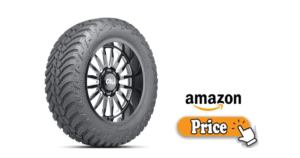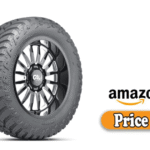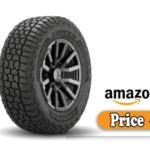If you’ve spent any time browsing off-road forums, tire review websites, or lifted truck Instagram pages, chances are you’ve come across AMP Tires. From aggressive tread patterns to bold sidewall designs, AMP Tires has developed a reputation among off-road and all-terrain enthusiasts.
But that raises a few important questions: Who makes AMP Tires? Are they any good? How do they perform? Are there better alternatives? We’ll explore who manufactures AMP Tires, evaluate their design and performance, and compare them to top competitors.
Whether you’re shopping for your next set of mud-terrain beasts or just curious about the brand, this is your one-stop AMP Tires review.
What I Like About AMP Tires
Let’s start on a positive note. AMP Tires offer several advantages that make them appealing to a specific crowd of drivers, especially those who love the great outdoors and off-road adventures.
1. Aggressive Styling
AMP Tires make a bold visual statement. Their sidewalls are aggressive, detailed, and stylish. Whether you’re rolling down a city street or tackling a muddy trail, these tires look the part.
2. Variety of Tread Options
AMP offers three main tread designs:
- Terrain Attack A/T A: All-terrain performance with everyday road comfort.
- Terrain Attack M/T A: Mud-terrain tire built for serious off-roaders.
- Terrain Pro A/T: Balanced tire ideal for drivers who split time between asphalt and trail.
3. Affordable Pricing
Compared to major tire brands like BFGoodrich, Nitto, or Toyo, AMP Tires are often more budget-friendly. For the features and performance you get, they’re competitively priced.
4. Wide Range of Sizes
From 17-inch rims to 26-inch monsters, AMP covers a wide selection. Whether you’re lifting a Jeep Wrangler, a Ford F-150, or a full-size Ram 2500, AMP likely has an option for you.
What Could Be Better
As with any product, AMP Tires are not without their drawbacks. Here’s a fair assessment of where they could improve.
1. Road Noise
Many users report noticeable road noise, particularly with the M/T (mud-terrain) models. That’s not unusual for off-road tires, but AMP’s treads can hum louder than some premium brands.
2. Wet Traction
AMP’s M/T tires can sometimes struggle in wet conditions. On slippery roads, braking distances increase, and handling may feel less confident.
3. Tread Life Variability
While many users get 40,000–50,000 miles from their A/T tires, others report uneven wear and faster degradation. This inconsistency might be due to tire balancing issues or quality control variability.
4. Limited Reputation
AMP is relatively new to the scene. Unlike legacy brands with decades of research and performance history, AMP is still building trust among hardcore off-roaders. 👉🏿👉🏻 Check The Latest Price and Offer at Amazon 👈🏻👈🏿
👉🏿👉🏻 Check The Latest Price and Offer at Amazon 👈🏻👈🏿
My Personal Experience
As an automotive enthusiast with a passion for trail riding, I’ve used everything from Goodyear Wrangler DuraTracs to Toyo Open Country M/Ts. My experience with AMP Terrain Attack M/T A tires was surprisingly good, especially considering the price point.
Here’s how they performed across various metrics:
Daily Driving
On city streets and highways, they were manageable but certainly louder than A/T tires. You’ll feel more vibrations at low speeds, but they smooth out nicely above 45 MPH.
Off-Road Conditions
In mud and loose dirt, they performed very well. I aired them down to 15 PSI for a trail ride in Moab, and the traction was impressive. No spinning, no fishtailing.
Snow Performance
AMP M/T tires are not winter-rated, but they handled light snow adequately. Deep snow was more challenging, but they’re not marketed as snow-specific tires anyway.
Durability
After about 12,000 miles, there was some edge rounding and minor cupping, but nothing drastic. They still have about 65–70% tread life left.
Design
Aggressive Looks with Purpose
AMP Tires are designed to turn heads and claw through terrain. Their sidewalls feature deep ridges and bold typography, often with multi-ribbed features that add to the aesthetics and functionality.
- Self-Cleaning Grooves: The tread voids are engineered to eject mud and stones, reducing the chance of debris buildup.
- Staggered Shoulder Blocks: Enhance off-road grip and lateral stability.
- Silica-Enhanced Compound: Helps with wet traction and improves tread wear.
Design is one of AMP’s strongest suits. These tires don’t just perform off-road; they look like they were built to survive an apocalypse.
Performance
Let’s break performance down into key areas:
1. Dry Traction: 8.5/10
AMP Tires feel secure and grippy on dry pavement. Cornering is stable, even with lifted trucks.
2. Wet Traction: 6.5/10
Wet handling is average to below average, especially with the M/T series. Braking distances are longer compared to top-tier brands.
3. Snow & Ice: 5/10
AMP doesn’t offer true winter-rated tires. Their all-terrain models can manage light snow but aren’t suitable for icy conditions.
4. Off-Road Grip: 9/10
In mud, gravel, rocks, and loose soil, AMP M/Ts are outstanding. They offer confidence on trails and steep inclines.
5. Tread Life: 7/10
You can expect around 40,000–50,000 miles from A/Ts and about 30,000–40,000 from M/Ts with proper rotation and inflation.
Build Quality
AMP Tires are manufactured in China and distributed by The Wheel Group (TWG), a U.S.-based company headquartered in California. TWG has been in the wheel and tire business for over 45 years and is also responsible for brands like Ion Alloy, Mayhem Wheels, and Mazzi.
While “Made in China” may give some buyers pause, AMP Tires have undergone DOT testing and certification. Many reviews praise their toughness and resistance to punctures, thanks to 3-ply sidewalls in most M/T models.
Alternative Option
If AMP Tires don’t quite check all your boxes, here are a few alternatives worth considering:
1. Nitto Ridge Grappler
- Great hybrid A/T-M/T performance.
- Quieter than AMP Tires.
- More expensive.
2. BFGoodrich All-Terrain T/A KO2
- Legendary durability.
- Better wet/snow handling.
- Slightly less aggressive sidewall appearance.
3. Toyo Open Country M/T
- Premium build.
- Exceptional off-road grip.
- High price point.
4. Falken Wildpeak A/T3W
- Winter-rated A/T tire.
- Great balance of comfort and off-road capability.
- Excellent value.
Read More: Goodyear Tires On Sale
Final Thoughts
Are AMP Tires Worth It?
Yes, with a few caveats. If you’re looking for affordable off-road tires with aggressive styling and good trail performance, AMP is a strong contender. Just be aware of the noise, potential wet traction issues, and shorter tread life compared to premium brands.
The Bottom Line
AMP Tires are best suited for:
- Off-road enthusiasts on a budget.
- Show trucks that prioritize appearance.
- Weekend warriors who occasionally hit the trails.
They may not be ideal for:
- Daily drivers need quiet, comfortable rides.
- Drivers in icy or extremely wet climates.
FAQs: Who Makes AMP Tires | My Honest Review
1. Who makes AMP Tires?
AMP Tires are manufactured in China and distributed by The Wheel Group (TWG), a U.S. company based in California.
2. Are AMP Tires good quality?
They offer good performance for their price, especially in off-road conditions. However, tread life and wet road performance may lag behind premium brands.
3. Are AMP Tires made in the USA?
No, they are made in China under quality control standards set by The Wheel Group.
4. Do AMP Tires perform well in snow?
AMP A/T models can handle light snow, but they’re not winter-rated. Look elsewhere if you frequently drive in snowy or icy conditions.
5. How long do AMP Tires last?
A/T models typically last around 40,000–50,000 miles, while M/T models may last closer to 30,000–40,000 miles, depending on driving habits and maintenance.
6. Where can I buy AMP Tires?
You can find AMP Tires at off-road specialty shops, tire retailers, or online marketplaces like Tire Rack, Amazon, and Discount Tire Direct.
7. Are AMP Tires noisy?
Yes, particularly the M/T models. The A/Ts are quieter but still more audible than highway tires.




